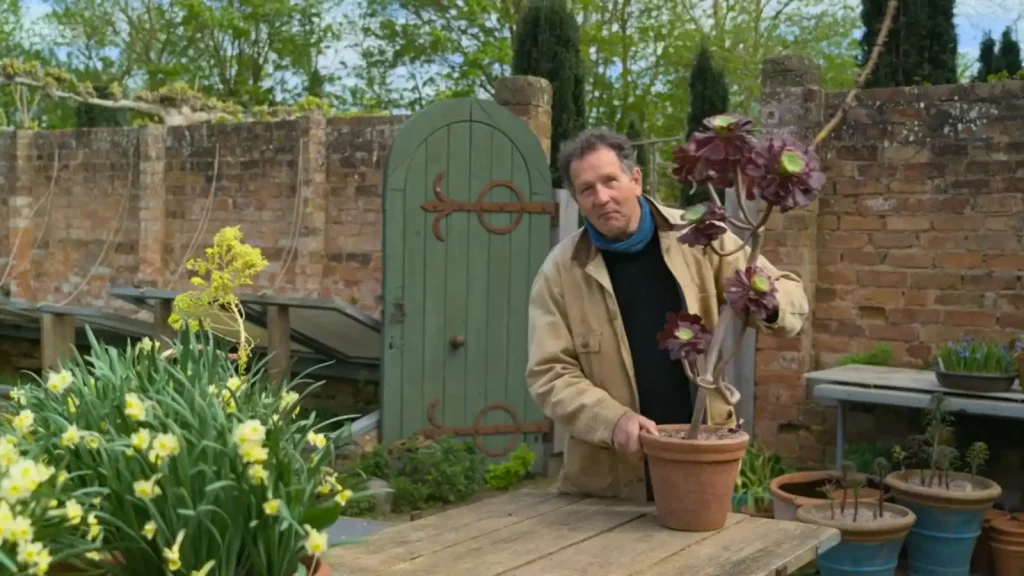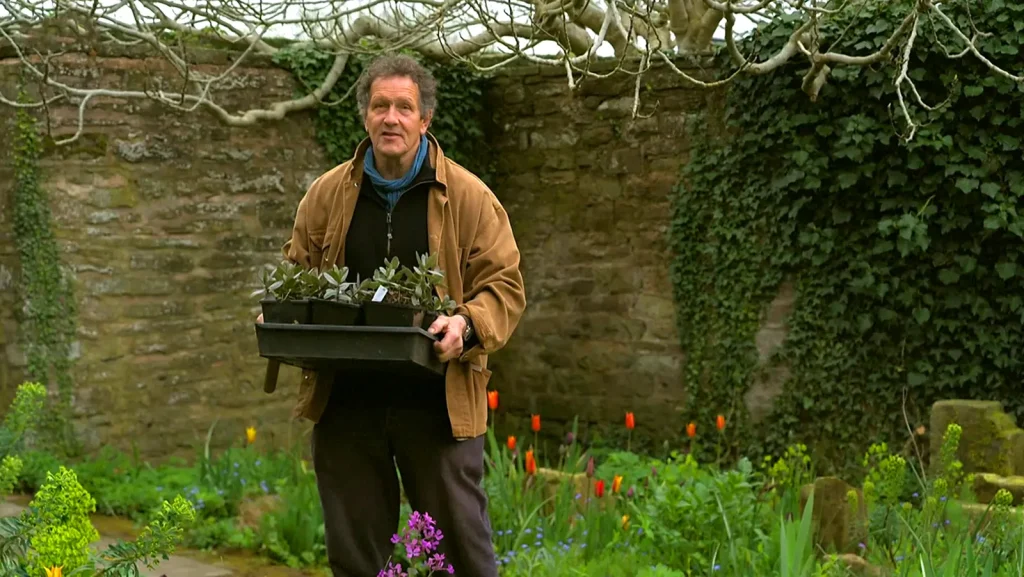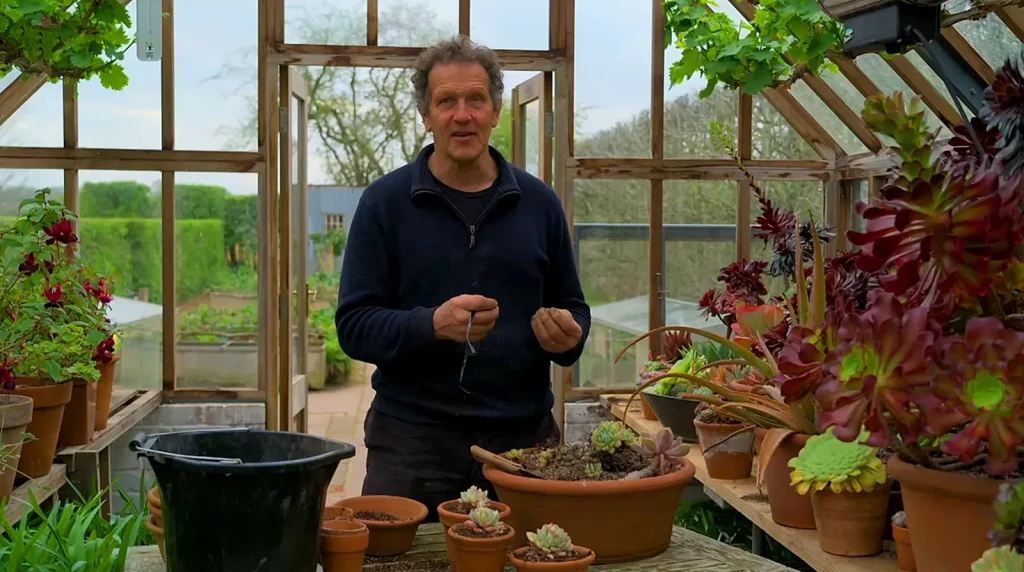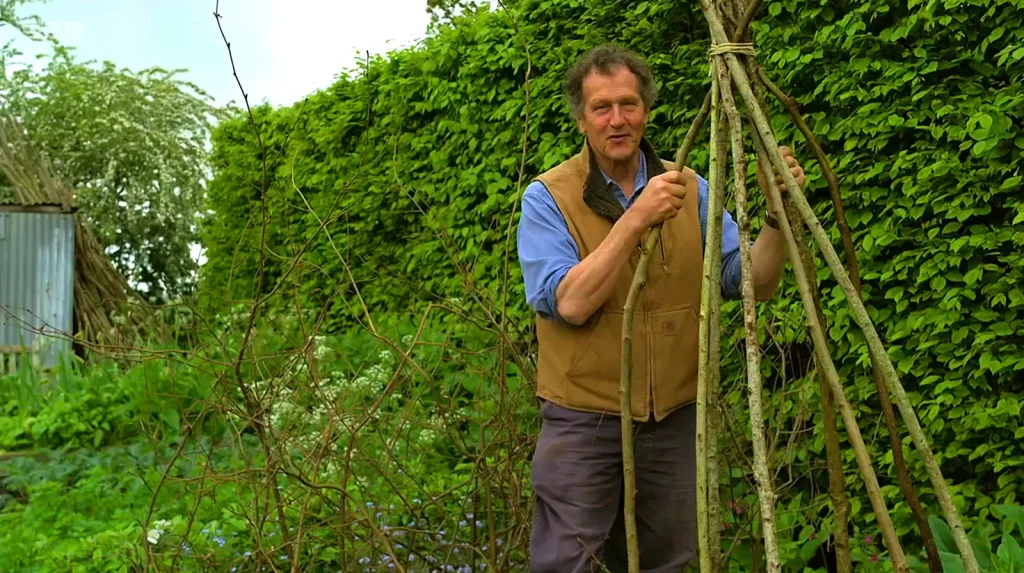Gardeners World 2024 Episode 10: We join Monty Don as he navigates the delicate world of succulents. With careful hands, he transitions his tender charges outdoors, embracing the warmth of the season. But that’s not all – Monty embarks on an ambitious quest to cultivate the elusive Himalayan poppies, renowned for their stubborn nature and affinity for shady nooks.
Our journey then takes us to Leicestershire, where a couple has achieved a remarkable feat – a garden that dazzles year-round with a kaleidoscope of bulbs, tubers, and corms. Adam Frost explores this horticultural wonderland, uncovering the secrets behind their perennial display.
Not far away, we meet a gardener whose passion transcended the hustle and bustle of city life. From scratch, she has crafted a verdant oasis, a testament to her unwavering determination and love for the craft.
In the picturesque North Yorkshire, Frances Tophill pays a visit to the gardens of Newby Hall, where a breathtaking display of candelabra primulas awaits. These delicate beauties will undoubtedly captivate with their vibrant hues and intricate forms.
But the horticultural delights don’t stop there. Just south of Glasgow, a dynamic mother-and-daughter duo prepares for their debut at the prestigious RHS Chelsea Flower Show. Their dazzling display of dahlias promises to steal the spotlight, a true celebration of these flamboyant blooms.
Throughout this episode, we bear witness to the unwavering dedication, creativity, and sheer joy that gardeners derive from nurturing their botanical masterpieces. Whether it’s the quest for elusive species, the pursuit of year-round beauty, or the thrill of showcasing one’s creations on the grandest of stages, these gardeners remind us that true passion knows no bounds.
Gardeners World 2024 Episode 10
The Complete Guide to Growing and Selecting Cut Flowers
Transform your garden into a vibrant oasis of color and fragrance with cut flowers. Not only do they enhance the beauty of your outdoor space, but they also provide a constant supply of fresh blooms for indoor arrangements. In this comprehensive guide, we’ll explore everything you need to know about growing and selecting cut flowers, from practical considerations to plant selection tips.
Practical Considerations
Adapting Existing Borders
When incorporating cut flowers into existing borders, opt for plants that can be picked without compromising the overall aesthetic. Plant larger groups of annuals, perennials, and bulbs suited for cutting. Integrate well-chosen shrubs and grasses with interesting foliage to add texture and variety.
Establishing a Cutting Garden
Dedicate a specific area of your garden to growing cut flowers exclusively. By doing so, you’ll ensure a continuous supply of blooms without depleting other garden beds. Plant or sow flowers in rows for easier maintenance, weeding, and harvesting. Remember to provide adequate spacing between rows to prevent overcrowding and damage to the plants.
Choosing the Right Site
Select a sunny location with fertile, weed-free soil for your cut flower garden. Regularly amend the soil with organic matter to improve moisture retention and soil structure. Consider moderate applications of fertilizers to promote healthy growth and abundant flowering. Additionally, mulching with composted manure or bark helps suppress weeds and retain moisture.
Plant Selection
Annuals
Annuals like sunflowers, cosmos, cornflower, and larkspur offer a wide range of colors and textures. Sow seeds annually or propagate plants in a greenhouse for extended flowering seasons.
Herbaceous Perennials
Choose perennials that provide a long season of picking, including foliage plants like Achillea and Echinacea. Start some perennials from seed early to encourage flowering in the same season.
Bulbs
Bulbs such as tulips and hyacinths are excellent additions to the cut flower garden, offering early blooms in late winter or early spring. Plant a variety of early, mid, and late-flowering cultivars for continuous blooms throughout the season.
Shrubs and Climbers
Incorporate evergreens and early-flowering shrubs like camellia and forsythia for winter and early spring cutting material. Certain climbers not only provide flowers but also attractive seed heads or fruits.
Propagation
Propagate hardy annuals by direct sowing outdoors or raise half-hardy annuals indoors. Perennials can be propagated from seed, division, basal cuttings, or root cuttings. Shrubs and climbers can be propagated through various methods such as softwood, semi-ripe, or hardwood cuttings.
With the right selection of plants and proper care, anyone can enjoy the beauty and abundance of cut flowers in their garden. Whether you’re a seasoned gardener or just starting out, follow these guidelines to create a stunning cutting garden that will provide endless joy throughout the seasons.
How to Grow Vegetables from Scraps: A Sustainable Guide
Growing vegetables may seem like a daunting task, but did you know you can start from the vegetables you already have? Recycling vegetable scraps not only reduces waste but also promotes sustainability. In this guide, we’ll explore various vegetables you can regrow from kitchen scraps, providing tips and insights from expert horticulturists.
The Veg That Keep on Giving
Your kitchen is a treasure trove for potential harvests. Instead of discarding certain vegetable parts, consider saving them for regrowth. Guy Barter, chief horticulturalist at the Royal Horticultural Society, suggests several vegetables ideal for regrowing, including sweet potatoes, fresh ginger, and yams. These vegetables, known as tubers, can be replanted to yield new crops.
Regrowing Tubers
To regrow tubers, simply plant them in pots and place them in a warm environment. Within weeks, shoots will emerge, indicating it’s time to transplant them outdoors. Additionally, cutting these tubers into sections and placing them in potting compost can accelerate the regrowth process.
Utilizing Cuttings and Spuds
Taking cuttings from potted vegetables, such as sweet potatoes and ginger, can also yield successful crops. Once the cuttings develop roots, they can be potted individually for outdoor planting. When it comes to regular supermarket potatoes, planting seed potatoes instead of store-bought ones is recommended to avoid potential diseases.
Harvesting from Seeds
Certain fruits and vegetables contain easily accessible seeds that can be planted to produce new crops. Seeds from ripe tomatoes, peppers, and strawberries can be extracted and sown for a late summer harvest. Additionally, various kitchen cupboard seeds, such as coriander and mustard, have the potential to grow if they’re not too old.
Utilizing Your Windowsill
Your windowsill can serve as a mini-garden for growing vegetables. Watercress, for instance, can be placed in jars of water in a bright spot to encourage root growth. Onions and garlic sprouting in your kitchen can be replanted in pots or garden borders for continuous harvests.
Sage Advice
While regrowing vegetables from scraps is rewarding, it’s essential to exercise caution. Avoid using seeds from non-food-grade sources, such as bird or pet food, as they may be harmful. Additionally, seeds from pumpkins and squash bought in supermarkets are preferable over those from homegrown ones, as they ensure a better-tasting harvest.
Growing vegetables from scraps is not only environmentally friendly but also a rewarding experience. By following the tips and advice provided in this guide, you can turn kitchen scraps into thriving vegetable gardens. Embrace sustainability and enjoy the satisfaction of harvesting homegrown produce.
A Comprehensive Guide on Growing Peas
Peas are not just delicious additions to your plate; they’re also easy to grow, making them an ideal addition to any garden. In this guide, we’ll explore everything you need to know about growing peas, from selecting the right variety to harvesting your bountiful crop.
Getting Started
Selecting the Right Variety
When it comes to peas, there’s a wide array of varieties to choose from, including garden peas, mangetouts, and sugarsnaps. Consider factors like pod color, plant height, and maturity period to select the best variety for your garden.
Preparing the Ground
Peas thrive in sunny locations with well-drained, slightly alkaline soil. Prepare your garden bed by weeding thoroughly and incorporating ample amounts of well-rotted manure or compost.
Sowing
Indoor Sowing
For an early start, consider sowing peas indoors in February or March. This protects the seeds from unfavorable outdoor conditions and ensures a reliable germination rate. Use deep modular trays or pots filled with multi-purpose compost for best results.
Outdoor Sowing
Outdoor sowing can be done from March to June, once the soil temperature reaches around 10°C (50°F). Ensure proper spacing between seeds, depending on the variety’s height, and protect seedlings from pests like slugs and snails.
Planting
Transplanting Seedlings
Plant indoor-raised or bought plants outdoors from March onwards, after hardening them off. Ensure proper spacing and support for taller varieties using netting or bamboo canes.
Plant Care
Watering
While peas are relatively low maintenance, consistent watering is crucial, especially during flowering and pod development. Avoid wetting the leaves to prevent powdery mildew and mulch around plants to retain soil moisture.
Supporting Plants
Most pea varieties require support to climb. Use netting, chicken wire, or pea sticks to provide adequate support, especially for taller varieties prone to becoming top-heavy.
Harvesting
Timing and Technique
Harvest peas regularly to encourage continuous production. Shelling peas are ready when the pods are well filled, while mangetouts and sugarsnaps should be picked when the pods are about 7.5cm (3in) long.
Common Problems
Pest and Disease Management
While peas are generally trouble-free once established, pests like mice, slugs, and snails can pose early challenges. Monitor for powdery mildew and pea moth damage, and take preventive measures accordingly.
F.A.Q.
Gardeners World 2024 Episode 10
Question 1.
Q.: What are the highlights of Gardeners World 2024 Episode 10?
A.: In Gardeners World 2024 Episode 10, Monty Don explores the delicate care and transition of succulents outdoors and undertakes the challenging task of growing Himalayan poppies. Additionally, Adam Frost visits a year-round vibrant garden in Leicestershire, and Frances Tophill showcases the stunning candelabra primulas at Newby Hall in North Yorkshire. The episode also features a mother-daughter duo preparing for their debut at the RHS Chelsea Flower Show with their spectacular dahlia display.
Question 2.
Q.: How does Monty Don handle succulents in this episode?
A.: Monty Don demonstrates the careful handling and transitioning of succulents outdoors, emphasizing the importance of gradually acclimating these tender plants to the warmer season to ensure they thrive. His expertise in managing succulents showcases the delicate balance required to nurture these popular yet sensitive plants.
Question 3.
Q.: What makes the Leicestershire garden visited by Adam Frost special?
A.: The Leicestershire garden featured in this episode is remarkable for its year-round display of bulbs, tubers, and corms. This garden’s consistent vibrancy and color throughout the seasons are attributed to the strategic planting and meticulous care by its dedicated owners, making it a horticultural wonderland that Adam Frost explores to uncover its secrets.
Question 4.
Q.: Who are the mother-daughter duo featured in this episode, and what are they preparing for?
A.: The episode introduces a dynamic mother-daughter duo from south of Glasgow who are preparing for their debut at the prestigious RHS Chelsea Flower Show. Their dazzling display of dahlias is poised to captivate the audience, highlighting their passion and skill in cultivating these flamboyant blooms.
Question 5.
Q.: What is the significance of Frances Tophill’s visit to Newby Hall?
A.: Frances Tophill’s visit to Newby Hall in North Yorkshire is significant as it showcases the breathtaking display of candelabra primulas. These delicate and vibrant flowers are a highlight of the garden, and Frances’ exploration offers viewers insight into the beauty and intricacies of maintaining such a stunning horticultural feature.
F.A.Q.
The Complete Guide to Growing and Selecting Cut Flowers
Question 1.
Q.: What are the practical considerations for growing cut flowers?
A.: Practical considerations for growing cut flowers include adapting existing borders with plants that can be picked without compromising aesthetics, establishing a dedicated cutting garden for continuous blooms, and choosing a sunny, fertile site with well-amended soil. Regular soil amendments, proper spacing, and mulching are also essential to ensure healthy growth and abundant flowering.
Question 2.
Q.: Which types of plants are ideal for a cutting garden?
A.: Ideal plants for a cutting garden include annuals like sunflowers and cosmos, herbaceous perennials such as Achillea and Echinacea, bulbs like tulips and hyacinths, and shrubs and climbers like camellia and forsythia. These selections offer a wide range of colors, textures, and blooming seasons, ensuring a constant supply of cut flowers.
Question 3.
Q.: How should one propagate plants for a cut flower garden?
A.: Propagation methods for a cut flower garden include direct sowing hardy annuals, raising half-hardy annuals indoors, and propagating perennials from seed, division, basal cuttings, or root cuttings. Shrubs and climbers can be propagated through softwood, semi-ripe, or hardwood cuttings, depending on the plant species.
Question 4.
Q.: What site conditions are best for growing cut flowers?
A.: The best site conditions for growing cut flowers are sunny locations with fertile, well-drained soil. Regular soil amendments with organic matter improve moisture retention and soil structure. Applying moderate amounts of fertilizers and using mulch such as composted manure or bark help suppress weeds and retain soil moisture.
Question 5.
Q.: How can one ensure continuous blooms throughout the season?
A.: Ensuring continuous blooms throughout the season involves selecting a variety of plants with different flowering periods, such as early, mid, and late-season cultivars. Regular maintenance, including deadheading spent flowers, proper watering, and timely fertilization, also promotes continuous flowering and healthy plant growth.
F.A.Q. Gardeners World 2024 Episode 10
Q.: What are the benefits of growing vegetables from scraps?
A.: Growing vegetables from scraps offers several benefits, including reducing waste, promoting sustainability, and providing a cost-effective way to produce fresh produce. This method leverages kitchen leftovers to regrow new crops, contributing to a more environmentally friendly and resource-efficient gardening practice.
Q.: Which vegetables are ideal for regrowing from kitchen scraps?
A.: Ideal vegetables for regrowing from kitchen scraps include tubers like sweet potatoes and ginger, as well as vegetables that can be propagated from cuttings, such as certain types of potatoes. Seeds from ripe tomatoes, peppers, and strawberries can also be sown to produce new crops, along with various kitchen cupboard seeds like coriander and mustard.
Q.: What are the steps to regrow tubers from scraps?
A.: To regrow tubers from scraps, plant them in pots and place them in a warm environment until shoots emerge. Once the shoots are visible, transplant them outdoors. Cutting tubers into sections and planting them in potting compost can also accelerate regrowth. Consistent watering and proper care will ensure successful crop development.
Q.: How can one use a windowsill to grow vegetables from scraps?
A.: A windowsill can serve as a mini-garden for growing vegetables from scraps. For instance, watercress can be placed in jars of water in a bright spot to encourage root growth. Sprouting onions and garlic can be replanted in pots or garden borders for continuous harvests. Utilizing windowsills maximizes indoor growing space and provides easy access to fresh produce.
Q.: What precautions should be taken when regrowing vegetables from scraps?
A.: When regrowing vegetables from scraps, it is important to avoid using seeds from non-food-grade sources, such as bird or pet food, as they may contain harmful substances. Additionally, seeds from pumpkins and squash bought in supermarkets are preferable over those from homegrown ones, as they are more likely to yield a better-tasting harvest. Exercise caution to ensure safe and successful regrowth.




